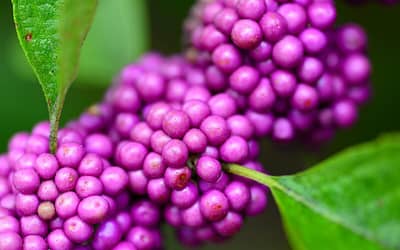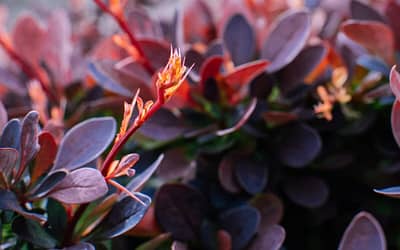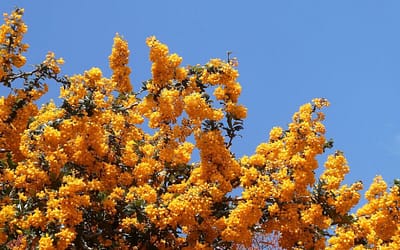Coronilla glauca Citrina
Glaucous Scorpion-Vetch

Position
- Full sun to partial shade
- Sheltered position protected from cold winds
- South or west-facing aspects are ideal.
Hardiness
- Hardy to -10°C (14°F)
- May need winter protection in colder areas of the UK
Soil Type
- Well-drained, fertile soil
- Tolerates most soil types but performs best in moisture-retentive, humus-rich soil.
Soil PH
- Slightly acidic to neutral (pH 5.5-7.0)
- Will tolerate mildly alkaline conditions.
Height
- Usually reaches 0.90-1.3 metres (3-4 feet) tall and wide.
Seasons of Interest
- Flowering period from June through to October
- Semi-evergreen foliage provides year-round interest
- Purple-bronze tints to foliage in autumn
- Attractive pink-tinged sepals persist after flowers fade
Additional Notes
- Pruning: Light pruning in early spring to maintain shape. Remove any frost-damaged growth
- Watering: Regular watering is needed during establishment and dry spells. Avoid waterlogging
- Fertilising: Apply balanced fertiliser in spring. Mulch annually with organic matter
- Growth Rate: Medium growth rate, taking 5-10 years to reach full size
- Companion Plants: Works well with other acid-loving plants like Hydrangeas and Japanese Maples
- Uses: Excellent for mixed borders, informal hedging, and container growing
- Winter Care: Consider applying mulch around the base in autumn for root protection
- Fragrance: Flowers are lightly fragrant, particularly noticeable in the evening
- Maintenance Level: Medium – requires regular attention but not demanding
- Wildlife: Attractive to bees and butterflies
-
Coronilla glauca Citrina: A Cheerful Evergreen Shrub for Winter Gardens
Coronilla glauca Citrina, also known as Coronilla valentina subsp. glauca Citrina, is a delightful evergreen shrub that offers bright yellow flowers and a sweetly scented bloom in late winter and early spring, providing much-needed colour. Its compact growth and vibrant foliage make it a must-have for any UK garden, especially during the colder months when cheerful colours are most needed. This article explores the plant’s key features, care tips, and why it deserves a place in your garden.
What Is Coronilla Citrina?
Coronilla Citrina is a compact evergreen shrub with bright yellow flowers that bloom in late winter. A pea family member, this plant features clusters of pea-like blooms followed by slender pods. Its blue-grey, pinnate leaves create an attractive backdrop, adding colour to even the dullest winter days.
This spectacular shrub grows to a height of approximately 180cm with a similar spread, making it ideal for smaller gardens or borders. Its bushy nature and year-round foliage make it a reliable garden addition.

Why Should I Choose Coronilla glauca for My Garden?
Coronilla glauca provides much-needed colour during winter, brightening your garden when most plants lie dormant. Its fragrant, lemon-yellow blooms bring cheer to cold days and offer a sweet scent that enhances the garden experience.
Additionally, its versatility makes it suitable for various planting styles, whether as a standalone feature, part of a border, or paired with herbaceous perennials, and it can thrive in south or west-facing gardens. The plant’s ability to thrive in sheltered spots and tolerate coastal conditions adds to its appeal.
When Does Coronilla Citrina Bloom?
Coronilla Citrina flowers from late winter well into spring, creating a much-needed splash of colour during the colder months. Its pale lemon flowers bloom abundantly, providing a vibrant display that transforms even the dullest garden.
The blooms are particularly valuable during winter days, offering a cheerful sight against a blue-grey backdrop. This flowering period aligns perfectly with the need for late-season vibrancy.
Where Should I Plant Coronilla glauca Citrina?
Plant Coronilla glauca in a south or west-facing sheltered spot to get the best results. It thrives in full sun, tolerating moderate frost if well-cared for, which is much needed in colder regions. A south-facing wall can provide additional shelter and warmth, protecting the shrub from extreme weather.
The plant prefers well-drained soil, making it ideal for garden beds or pots. Whether in the centre of a sunny border or as a potted feature on a patio, Coronilla glauca adds year-round interest to your space.
How Do I Care for Coronilla Citrina?
Caring for Coronilla Citrina is straightforward. Ensure it receives plenty of sunlight, regular watering, and a well-drained soil environment. During dry spells, water consistently to prevent the soil from drying out completely.
Prune the shrub after flowering to maintain its bushy growth and encourage new blooms. Use a balanced fertiliser annually to support healthy foliage and flower production.
Can Coronilla Citrina Tolerate Coastal Conditions?
Yes, Coronilla Citrina is a hardy plant that tolerates coastal gardens. Its ability to withstand salt-laden winds makes it an excellent choice for gardens near the sea.
The evergreen shrub thrives in various environments, bringing colour and cheer to coastal and inland gardens alike.
How Big Does Coronilla Citrina Grow?
Coronilla Citrina typically reaches a height and spread of approximately 90–180cm. Its compact size makes it suitable for small gardens or confined spaces.
Despite its bushy appearance, this plant remains easy to manage, fitting seamlessly into various garden styles and layouts.
What Makes This Shrub Suitable for UK Gardens?
Coronilla citrina is quite fully hardy, tolerating UK winters with proper care, making it a much-needed addition for gardeners. Its ability to bloom during late winter and early spring makes it a valuable addition to British gardens.
The RHS recommends this plant for its reliable performance, evergreen foliage, and pale, lemon-yellow flowers. Its sweetly scented blooms provide a sensory delight that’s hard to match.
Is Coronilla Glauca Citrina Available for Mail Order?
This shrub is available in many nurseries and online stores, including Swift Plants. A 3-litre pot ensures a well-established plant is ready to thrive in your garden.
Tips for Pruning and Encouraging Growth
To keep Coronilla healthy and vibrant, prune it annually after flowering. This prevents the shrub from becoming too woody and encourages new blooms.
Use sharp, clean tools to remove any dead or damaged branches. Regular pruning ensures a bushy growth habit and maintains its compact size.
Key Points to Remember
- Bright Winter Blooms: Coronilla Citrina produces fragrant yellow flowers from late winter into spring.
- Evergreen Foliage: Its blue-grey leaves provide year-round interest, enhancing garden aesthetics.
- Care Needs: Thrives in full sun, well-drained soil, and sheltered spots. Prune annually for best results.
- Compact Growth: Reaches a height and spread of 90–180cm, suitable for small gardens or coastal areas.
- Ideal for UK Gardens: Hardy and low-maintenance, perfect for brightening dull winter days.
Coronilla glauca Citrina is a spectacular shrub that brings much-needed colour to any garden. Its evergreen foliage, sweetly scented flowers, and vibrant winter blooms make it a standout choice for gardeners seeking year-round interest.
For more information on Shrubs, please click here.
Frequently Asked Questions
Q: What is Coronilla valentina subsp. glauca ‘Citrina’?
A: Coronilla valentina subsp. glauca ‘Citrina’, commonly known as bastard senna, is a compact, evergreen shrub that brings vibrant colour to the garden. It produces clusters of bright yellow, pea-like flowers in late winter and early spring, providing a welcome splash of brightness during the colder months.
Q: How tall does Coronilla glauca grow?
A: This shrub typically grows between 90cm and 180cm in height, depending on growing conditions and care. It’s an excellent choice for adding structure and vertical interest to your garden.
Q: Where can I buy Coronilla valentina subsp. glauca ‘Citrina’?
A: Coronilla valentina subsp. glauca ‘Citrina’ can be found at garden centres and online retailers. Many specialist plant nurseries also stock it, making it easy to source for your garden.
Q: What’s the best location for planting Coronilla valentina subsp. glauca ‘Citrina’?
A: Plant your bastard senna in a sunny, sheltered spot with a south or west-facing aspect. It thrives in well-drained soil and benefits from protection against harsh winter winds.
Q: How often should I water my Coronilla glauca?
A: Once established, Coronilla glauca is relatively low-maintenance. Water it regularly during dry spells, but avoid overwatering, as it dislikes sitting in waterlogged soil.
Q: When can I expect flowers from my Coronilla glauca?
A: This plant produces cheerful yellow flowers from late winter into early spring, adding colour when most other plants are dormant.
Q: Is Coronilla valentina subsp. glauca ‘Citrina’ suitable for year-round interest?
A: Yes! This shrub provides year-round interest with its evergreen foliage and seasonal flowering display. Given the proper care, it will remain an attractive feature in your garden throughout the seasons.
Q: Does Coronilla valentina subsp. glauca ‘Citrina’ need feeding?
A: Yes, for best results, feed your plant with a balanced, slow-release feed in spring. This will encourage healthy growth and prolonged flowering.
Related Articles
Callicarpa bodinieri Profusion
Beauty Berry Full sun or partial shade A sheltered position is beneficial, especially in exposed areas. Hardy to -15°C (5°F) It can tolerate colder temperatures with good drainage and winter protection (mulch) Well-drained soil is essential It tolerates various soil...
Acanthus mollis Snowstorm
Bear's Breeches Full sun or partial shade. Sheltered position is beneficial. Hardy to -15°C (5°F) Tolerates colder temperatures with good drainage and winter mulch. Well-drained soil Tolerates a range of soil types, including clay, but avoid waterlogged conditions....
Berberis thunbergii
Japanese Barberry Full sun to partial shade Best colour development in full sun Sheltered from strong winds Any aspect except deep shade Tolerates coastal conditions Suitable for urban areas Hardy down to -20°C (-4°F) Young growth susceptible to late spring frosts...
Berberis thunbergii Atropurpurea
Purple Japanese Barberry Full sun for best purple foliage colour Partial shade tolerated but may reduce colour intensity Sheltered from strong winds Urban-tolerant Suitable for coastal gardens Any aspect except deep shade Hardy down to -20°C (-4°F) Young growth...
Mycorrhizal Fungi
Mycorrhizal fungi form remarkable partnerships with plant roots, dramatically improving nutrient uptake and overall plant health. This comprehensive guide explores how to effectively utilise mycorrhizal fungi in your garden, boosting your plants' growth and resilience...
Plant Nutrition and Growth
Understanding plant nutrition and growth is essential for any gardener. This section of our website is dedicated to helping you nurture healthy, thriving plants. By grasping the fundamental aspects of nutrition, you can enhance your gardening skills and achieve...
Berberis darwinii
Full sun to partial shade Sheltered from harsh winds East or north-facing aspects suitable Tolerates coastal conditions Avoid deep shade Hardy down to -15°C (5°F) Young growth susceptible to late spring frosts Good winter hardiness once established Protect young...
Oak-Leaved Hydrangea – Hydrangea Quercifolia
Partial shade to full sun Protected from strong winds Morning sun with afternoon shade ideal North or east-facing aspects Woodland garden settings excellent Hardy down to -15°C (5°F) Young growth susceptible to late spring frosts More cold-hardy than mophead...
Mophead Hydrangea – Hydrangea macrophylla
Partial shade to full sun, avoiding harsh afternoon sun Sheltered position away from cold winds North or east-facing aspects ideal Morning sun with afternoon shade optimal Protection from late frosts essential Hardy down to -10°C (14°F) Young growth susceptible to...







